Rear wheel bearings - renewal
Saloon, Hatchback and Estate
models
With rear drum brakes
Note: There are two types of bolts used to
secure the rear hub carrier to the lower arm
(see illustration).
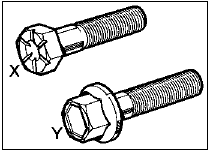
14.1a Alternative types of rear hub carrierto- lower arm securing bolts
The two types of bolt must not be mixed on a vehicle, but can be changed in complete sets for the alternative type. A complete set is eight bolts, four each side.
Note that the two types of bolt have different torque wrench settings. When renewing the wheel bearings a suitable puller will be required to remove the drive flange, and a new rear hub nut must be used on reassembly.
1 Loosen the rear hub nut with the vehicle resting on its wheels. On early models, relieve the staking before loosening the nut (see illustration).
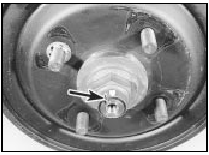
14.1b On early models relieve the staking (arrowed) on the rear hub nut
Later models use self-locking nuts, and it is important to note that where this type of nut is fitted, the left-hand nut has a left-hand thread, ie. it is undone in a clockwise direction. Before loosening the nut, ensure that the handbrake is applied, and chock the relevant rear wheel. A suitable extension bar will be required, as the nut is extremely tight.
2 Loosen the rear roadwheel nuts on the side concerned, chock the front wheels, and jack up the rear of the vehicle and support on axle stands (see “Jacking and Vehicle Support”).
Remove the rear roadwheel.
3 Remove the brake drum retaining spire washer(s) from the wheel stud(s) and remove the brake drum. Ensure that the handbrake is released before removing the brake drum, otherwise the drum will be held in place by the clamping action of the brake shoes.
4 Remove the two nylon fasteners, and remove the plastic shield from the rear of the brake backplate (see illustration).
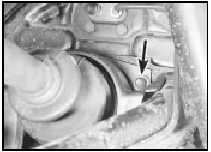
14.4 Remove the nylon fasteners (arrowed) to free the plastic shield from the
brake backplate
5 Unscrew and remove the rear hub nut.
6 Using a suitable puller, pull the drive flange from the end of the driveshaft (see illustration).
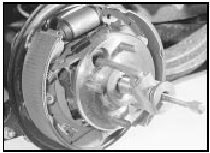
14.6 Pull the drive flange from the end of the driveshaft
7 Unscrew and remove the four bolts securing the hub carrier and brake backplate to the lower arm (see illustration).
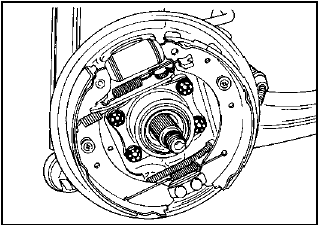
14.7 Rear hub carrier/brake backplate-to-lower arm securing bolts
Remove the hub carrier, whilst supporting the driveshaft. Support the driveshaft by placing axle stands underneath it, or by securing with string to the underbody. Note that the driveshaft joints should not be allowed to deflect through an angle exceeding 13º.
8 Refit the brake backplate with the four securing bolts to avoid straining the brake pipe.
9 With the hub carrier removed, the bearings can be renewed as follows (see illustration).
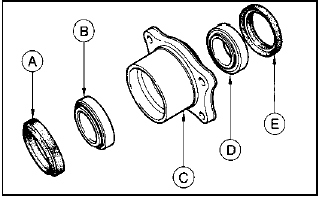
14.9 Rear hub carrier components - Saloon, Hatchback and Estate models
A Outer oil seal
B Outer bearing
C Hub carrier
D Inner bearing
E Inner oil seal
10 Prise the inner and outer oil seals from the hub carrier using a suitable screwdriver, and withdraw the taper roller bearings.
11 Using a soft metal drift, drive the bearing outer races from the hub carrier, taking care not to damage the inner surface of the carrier.
12 Clean the hub carrier and drive flange with paraffin, wipe dry and examine for damage and wear. Note that the components are machined to very close tolerances, and the bearings are supplied in matched pairs, therefore scrupulous cleanliness must be observed.
13 Using a metal tube of suitable diameter, drive the new bearing outer races fully into the hub carrier. Ensure that the races are seated correctly.
14 Pack the inner bearing races and rollers with high-melting-point lithium-based grease, and locate the outer bearing assembly in the hub carrier.
15 Fill the cavities between the sealing lips of the oil seal with grease, then drive it fully into the hub carrier using a block of wood or a metal tube of suitable diameter. Note than on early models the oil seal has a rubber casing, and this type of seal should be replaced with the later type which has a metal casing. The oil seal should be renewed regardless of type, and a new oil seal of the correct type is normally supplied with the new wheel bearings.
16 Repeat the procedure shown in paragraphs 14 and 15 for the outer bearing and oil seal.
17 Fit the drive flange to the hub carrier in order to centralise the bearings, then remove the securing bolts from the brake backplate, and using a soft-faced mallet, drive the drive flange/hub carrier assembly onto the end of the driveshaft.
18 Further refitting is a reversal of removal, bearing in mind the following points.
19 Refit the hub carrier/brake backplate-to-lower arm securing bolts with reference to the note at the beginning of this sub-Section.
20 Fit a new rear hub nut of the correct type, and tighten it with the vehicle resting on its roadwheels. Apply the handbrake and chock the relevant rear wheel. If a staked type nut is used, lock the nut by staking its outer ring into the groove in the driveshaft.
With rear disc brakes
Note: See note.at the beginning of this Section
21 Loosen the rear hub nut with the vehicle
resting on its wheels. Note that the left-hand
nut has a left-hand thread, ie. it is undone in a
clockwise direction. Before loosening the nut,
ensure that the handbrake is applied, and
chock the relevant rear wheel. A suitable
extension bar will be required, as the nut is
extremely tight.
22 Loosen the rear roadwheel nuts on the side concerned, chock the front wheels, and jack up the rear of the vehicle and support on axle stands. Remove the roadwheel and release the handbrake.
23 Unbolt the brake caliper carrier bracket and support the caliper on an axle stand, taking care not to strain the flexible hose.
24 Mark the position of the brake disc in relation to the drive flange, remove the retaining spire washer(s), and remove the disc.
25 Unscrew and remove the rear hub nut, and using a puller, pull off the drive flange.
26 Unscrew the four bolts securing the hub carrier and splash shield to the lower arm.
Remove the hub carrier and splash shield, whilst supporting the driveshaft. Support the driveshaft by placing axle stands underneath it, or by securing with string to the underbody.
Avoid bending the driveshaft joints to excessive angles, and do not allow the shaft to hang down from one end.
27 With the hub carrier removed, the bearings can be renewed as described in paragraphs 10 to 16 of this Section.
28 Fit the drive flange to the hub carrier in order to centralise the bearings, then using a soft-faced mallet, drive the drive flange/hub carrier assembly onto the end of the stub axle.
Do not forget to fit the splash shield.
29 Further refitting is a reversal of removal, bearing in mind the following points.
30 Refit the hub carrier/splash shield-to-lower arm securing bolts with reference to the note at the beginning of this sub-Section.
31 When refitting the brake disc, align the previously made marks on disc and drive flange.
32 Fit a new rear hub nut of the correct type, and tighten it with the vehicle resting on its roadwheels. Apply the handbrake and chock the relevant rear wheel.
P100 models
Note: A new rear hub nut must be used on
reassembly.
33 Remove the relevant driveshaft.
34 Relieve the staking on the rear hub nut, and using a 50 mm socket and an extension bar, unscrew the nut. Note that the nut is extremely tight.
35 Pull off the hub, and remove the O-ring and spacer sleeve from the recess in the hub (see illustration).
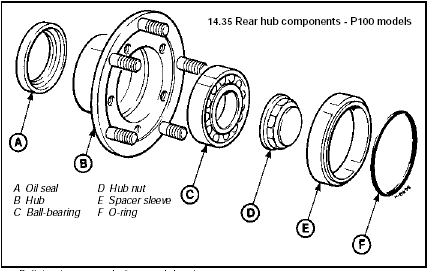
14.35 Rear hub components - P100 models
A Oil seal
B Hub
C Ball-bearing
D Hub nut
E Spacer sleeve
F O-ring
36 Prise the oil seal from the rear of the hub using a screwdriver.
37 Using a block of wood, or a suitable metal tube inserted from the rear of the hub, tap out the ball-bearing.
38 Clean the hub with paraffin, wipe dry and examine for damage and wear.
39 Using a metal tube of suitable diameter, resting on the bearing outer race only, tap the new bearing into the hub. Ensure that the bearing is correctly seated.
40 Carefully fit a new oil seal to the rear of the hub, using a suitable metal tube.
41 Refitting is a reversal of removal, bearing in mind the following points.
42 Fit a new rear hub nut, and stake in position after tightening to the specified torque.
See also:
Buying Spare Parts
Spare parts are available from many sources,
including maker’s appointed garages, accessory
shops, and motor factors. To be sure of
obtaining the correct parts, it will sometimes be
necessary to q ...
Weber 2V carburettor - removal and refitting
Note: Refer to the warning at the end of
Section 1 before proceeding.
XR3 models
Removal
1 Disconnect the battery negative lead.
2 Remove the air cleaner as described in
Section 2.
3 Disconnect ...
Cylinder head - removal and refitting (engine removed)
Note: The cylinder head bolts must always be
renewed after slackening, and a new cylinder
head gasket and camshaft cover gasket must
be used on refitting. If the engine has recently
run, the cylin ...
